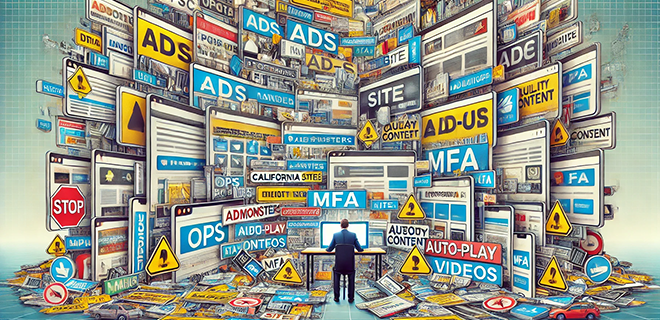
Discover how generative AI is driving a near-20% increase in “Made for Advertising” (MFA) sites, and learn from DoubleVerify’s Chief Innovation Officer, Jack Smith, how to navigate this evolving trend.
When it comes to ad tech, Jack Smith is no stranger to innovation. With over 25 years of experience and seven patents in AI and machine learning, DoubleVerify’s Chief Innovation Officer knows a thing or two about navigating the digital wild west. In DoubleVerify’s latest Global Insights Report, they uncovered a nearly 20% surge in MFA sites, fueled by the rapid rise of AI-generated content.
The report reveals that MFA impression volume increased by 19% in 2023, with a staggering 73% jump in “Low-tier” MFA impressions. These sites, which blend MFA and non-MFA characteristics, are reshaping the internet faster than a Netflix show drops spoilers.
Using advanced AI technology, DoubleVerify analyzed over three dozen “High-tier” MFA websites, finding numerous instances of likely AI-written content, including examples like HeroInvesting’s Clint Eastwood aging article and Noteabley’s Best Steakhouses list. These sites often bombard users with ads, making the user experience as pleasant as navigating through a maze of pop-up ads in the early 2000s.
In this Q&A, Smith breaks down the complexities of distinguishing high-quality AI content from the low-tier junk flooding the internet. We dive into DoubleVerify’s sophisticated blend of AI and human review and explore how advertisers can protect their investments amid the explosion of MFA sites.
Join us as this ad tech luminary shares his insights and strategies for staying ahead in the ever-evolving world of AI-driven ad tech. Whether you’re an advertiser looking to make the most of your budget or a publisher striving to maintain quality, this conversation is packed with valuable takeaways.
 Lynne d Johnson: Your report touches on the surge in MFA sites. However, the digital landscape often sees legitimate sites misclassified as MFAs due to their ad strategies or content distribution tactics. Can you explain DoubleVerify’s criteria for distinguishing true MFA sites from legitimate content sites that might superficially appear similar due to high ad-to-content ratios or aggressive monetization strategies?
Lynne d Johnson: Your report touches on the surge in MFA sites. However, the digital landscape often sees legitimate sites misclassified as MFAs due to their ad strategies or content distribution tactics. Can you explain DoubleVerify’s criteria for distinguishing true MFA sites from legitimate content sites that might superficially appear similar due to high ad-to-content ratios or aggressive monetization strategies?
Jack Smith: This is a great point, and thank you for raising it. When it comes to MFA content, we believe nuance and surgical categorization — not blunt, one-size-fits-all lists — are key to safeguarding advertiser investments and supporting quality publishers and, more broadly, the open internet.
We were the first verification vendor to really define MFA content in an effort to create a common yardstick from which to evaluate. While we have a clear overall definition — DV defines MFA sites as those whose sole purpose is to deliver advertisements — our definition also considers nuance. MFA sites can be identified by analyzing several factors across their ad monetization activities, ad traffic sources, and approach to content creation. That combination of criteria needs to be robust to properly distinguish content in a way that’s fair and equitable for content creators.
With that in mind, DV’s approach allows for the deepest and most nuanced level of analysis, preventing miscategorization and false positives. For example, a website may feature a significant number of ads while still registering high rates of direct and search-enabled traffic. In this instance, the publisher would not meet our definition of MFA. For sites we do classify as MFA, we have a tiered system of high (more egregious examples), medium, and low. Advertisers can then make decisions on the tiers and how they best fit or don’t fit into their campaigns. For DV to classify a site as MFA, it really needs to consistently show high signs of arbitrage both in terms of heavy reliance on paid traffic and arbitrage traffic.
For DV to classify a site as MFA, it really needs to consistently show high signs of arbitrage both in terms of heavy reliance on paid traffic and arbitrage traffic.
Also, just as an inclusion or exclusion list-only approach doesn’t allow for nuance in categorization, we don’t solely rely on AI for classifying content. Algorithms can be biased just like people and are not infallible. To ensure protection and support publisher monetization, we blend AI with expert human review to help ensure that sites that don’t ultimately qualify as MFA content, including those owned by underrepresented groups or news publishers, are not incorrectly flagged. We also regularly audit our categorization criteria, which is critical as the space evolves quickly.
As a result, publishers have embraced and supported our MFA solution. We also developed it with feedback from the community to ensure responsible and thoughtful categorization.
LdJ: With the report highlighting a 19% increase in MFA sites largely driven by AI-generated content, how does DoubleVerify differentiate between low-quality AI-generated content and high-quality AI content that might also be prolific in ad placements? Are there specific markers or technology you use to make this distinction clear?
JS: AI-generated content is an interesting topic because there is often a rush to judgment. Just as many rush to say all MFA content is fraudulent or bad, we’ve seen the same about AI content. Ultimately, AI-supported content can range from high to low quality. We’ve seen trusted publishers in the financial space, for example, rely on AI for quality reporting for years. AI can be an additive tool for quality journalism.
At DV, for these reasons, we don’t automatically or bluntly label AI content as “bad.” However, we do believe it’s problematic when AI is used to create low-quality content at scale, while coupling that with a heavy reliance on paid and arbitrage traffic to take in ad dollars that would otherwise go to quality publishers. For instance, DV has found some sites that publish in excess of 1,000 pieces of content per day, powered by AI. That level of output usually comes at a cost to quality. We factor these considerations into our evaluations of MFA and quality more broadly.
As new Gen AI tools have emerged, tracking AI content can be a difficult task given its growing volume. To help us with this process, we built our own proprietary AI to detect and analyze replicated and AI-generated content across the web. In doing so, we also gain so much more data and signals to help better understand the use of AI in MFAs, but also fraud and other areas.
LdJ: Given the significant growth in ‘Low-tier’ MFA impressions, could you elaborate on the real-world impact this surge has on publishers and advertisers? How do these ‘Low-tier’ MFA sites specifically dilute the efficacy of digital advertising campaigns, and what measures can advertisers take to safeguard their interests?
JS: The growth of low-tier MFAs really speaks to the earlier topic you raised about nuance and categorization. What we classify as “low-tier” covers sites or sections with a blend of MFA and non-MFA content — for example, sites where only a section or a subdomain exhibits MFA content or characteristics. These publishers make up the highest percentage of MFA publishers, which highlights the need to have different tiers so they can be treated differently.
Ultimately, we classify, and it is up to the advertiser to determine if MFA inventory aligns with their own performance outcomes and is suitable for their brand. However, by having this nuanced categorization, brands have the freedom and tools to decide if and to what extent they want their ads to be served on MFA sites.
LdJ: As AI technology evolves, so too do the strategies for generating and monetizing content on MFA sites. What are DoubleVerify’s plans for staying ahead in this technological arms race, particularly in terms of improving detection mechanisms and helping advertisers avoid these pitfalls?
JS: We heavily invest in R&D at DV, more than any other verification provider, and most other technology companies in our space. This emphasis on innovation has given us a substantial lead in the market, providing an edge over tech advancements that may negatively impact advertiser investments and transparency. This strategic focus ensures we anticipate future developments and adapt quickly.
Beyond the tech, the arms race in AI isn’t just about countering the technology itself — it’s also about aligning with a brand’s preferences for how advertising is incorporated into an environment. Effective policy plays a critical role in maintaining this alignment, ensuring that our solutions continually meet the evolving needs of advertisers.
LdJ: With the proliferation of MFA sites and AI-generated content, what are the broader ethical implications for the digital ecosystem? How does DoubleVerify envision the future of online content quality, and what role do you believe regulatory bodies should play in curbing the growth of low-quality, ad-centric platforms?
JS: This is a great question. AI-generated content is already subject to some regulation, and it’s inevitable that more regulations will emerge. As the technology improves, the regulatory landscape is likely to evolve and expand, which we support to help ensure the safety of the Internet.
Interestingly, these regulations often focus on end-consumer protection and enhancing transparency rather than directly curbing the creation of the content. This means that AI-generated content will continue to proliferate within the digital ecosystem. Even if it’s labeled transparently due to new rules or standards implemented by large tech companies, we, at DV, need to help advertisers navigate this growth. Our role is to support their ability to advertise safely and effectively alongside and around this content, but really any content, whether AI-created or not.
__
Jack is responsible for ensuring alignment between DV’s commercial and product organizations. He manages senior level product relationships with key customers, identifies new client-driven product opportunities and supports sales efforts. Prior to joining DV, Jack served as Global Chief Product Officer, Investment at Group M, where he developed products and platforms that empowered teams to make better decisions about where to invest over $80 billion of media spend. Previously, Jack co-founded the machine learning company Solariat, which was acquired by Genesys. He brings over 25 years of experience in executive strategy, technology, client and market insight to his role as Chief Innovation Officer. Jack holds seven patents in AI and machine learning for signal detection in natural language and the prediction of consumer media consumption.